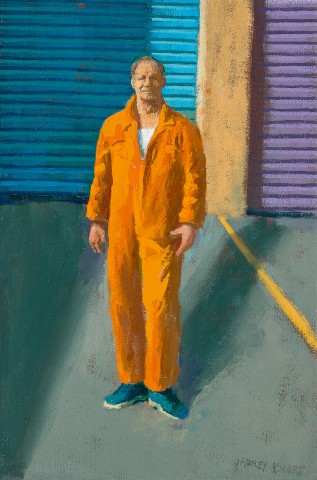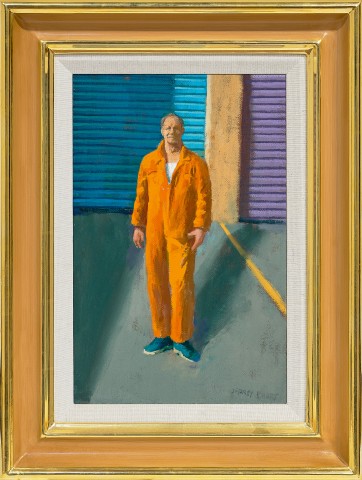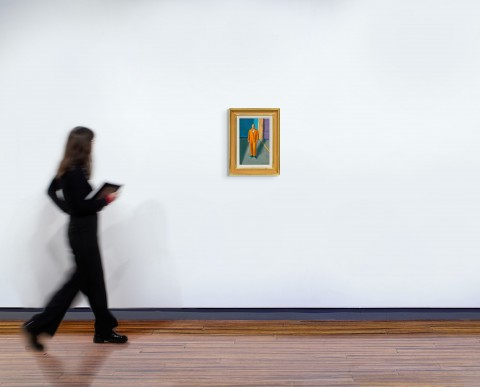(1921 - 2013)
Jeffrey Smart
Third study for Portrait of Bruce Beresford, 2009
oil on canvas
Australian Galleries, Melbourne (label attached verso, AG105621)
Private collection, Melbourne
Jeffrey Smart: Paintings and Studies 2006 – 2010 and One Drawing from 1946, Australian Galleries, Melbourne, 11 – 30 May 2010, Australian Galleries, Sydney, 22 June – 10 July 2010, cat. 4
Portrait of Bruce Beresford, 2009, oil on canvas, 94.0 x 130.0 cm, private collection
We are grateful to Stephen Rogers, Archivist for the Estate of Jeffrey Smart, for his assistance with this catalogue entry.
‘There’s always a kind of playfulness about the way Jeff sees you when he’s painting a portrait…’ 1
Although Jeffrey Smart remains unequivocally best known for his beguiling, meticulously composed cityscapes that rejoice in the everyday beauty of the modern urban environment (see lot 16), portraiture nevertheless occupies a small but significant place in his rich oeuvre. Whether it be the intermittent self-portraits executed every few years as Smart monitored his aging visage, the ‘named’ portraits of celebrated identities such as David Malouf, Clive James, Margaret Olley and Bruce Beresford (featured here), or the ‘unnamed’ portraits of actual people included anonymously in his compositions (most frequently, his long-term partner Ermes de Zan), Smart’s portrayals reveal innately human and humane qualities – offering intriguing insights into not only the people depicted, but the artist’s relationship with them and the very nature of his art.
Among his final portrait endeavours, Third study for Portrait of Bruce Beresford, 2009, immortalises one of the artist’s dearest lifelong friends – the eponymous Australian Academy award-winning film and opera director whose achievements include Driving Miss Daisy (1989) and Mao’s Last Dancer (2009). Incidentally, the two first met in 1955 at The King’s School in Parramatta where Smart was the art master and Beresford, a self-professed ‘gormless pupil’; Smart later recollected Beresford was the only student he ever met who contradicted his belief that ‘anyone can be taught to draw.’2 A few years later in 1958, while working as a camera assistant for the Australian Broadcasting Commission, Beresford was sent on assignment to cover a highly anticipated art show in Circular Quay which, to his amazement, turned out to be Smart’s latest solo exhibition at Australian Galleries, and again in 1963, the two serendipitously crossed paths during the six-week voyage to Europe aboard the Castel Felice passenger ship. As Beresford reminisces, Smart was delighted to have discovered such a keen enthusiast of his art and they whiled away the long journey discussing the art of Cézanne, Léger, Matisse and the Italian Renaissance masters (especially Piero della Francesca), the poetry of T.S. Eliot, and the most arcane plots of the great novelists – all laced with salacious gossip about other artists and their foibles.3 Thenceforward, Smart and Beresford shared a close friendship that endured until the artist’s death in 2013, with Beresford frequently visiting his mentor at his farmhouse near Arezzo in Tuscany, and more recently, paying poignant homage to Smart in an essay for the catalogue accompanying the major retrospective organised by the National Gallery of Australia.
Imbued with the nostalgia of an elderly artist reflecting upon his life, not surprisingly the present study bears echoes of Smart's earlier achievements, revisiting poetic ideas and motifs that gain fresh meaning from being assembled in a different configuration. Not only does Smart here depict Beresford in the bright orange worker’s overalls ubiquitous throughout his oeuvre – and similarly employed (in an ochre variation) for his portrait of expatriate poet and novelist, David Malouf, in 1980 – but he also incorporates the coloured roller doors from his 1982 painting entitled The four closed shops (private collection) which, then emblazoned with the names of well-known Italian artists, presented a wry comment upon the nature of the local art scene. Moreover, just as ‘private jokes and gamesmanship’ notoriously punctuate Smart’s portraits of celebrity friends such as Clive James, Germaine Greer and David Malouf4, so too the present portrait betrays the artist’s droll and subtle wit – the ‘closed shops’ featured as a backdrop presumably alluding to Beresford’s difficulties in getting Hollywood to back his film projects at the time.5
1. David Malouf, cited in ‘David Malouf and Jeffrey Smart – Portrait of a Friendship’, in Jeffrey Smart, National Gallery of Australia, Canberra, 2021, p. 128
2. Beresford, B., ‘Jeffrey and Me’ in Jeffrey Smart, ibid., p. 121
3. ibid., p. 122
4. McDonald, J., ‘Jeffrey Smart’, Jeffrey Smart Recent Paintings, Philip Bacon Galleries, Brisbane, 2001, p. 3
5. See McDonald, J., ‘Jeffrey Smart’, Art Column, 26 June 2010 at: https://www.johnmcdonald.net.au/2010/jeffrey-smart/ (accessed 30 July 2025)
VERONICA ANGELATOS


